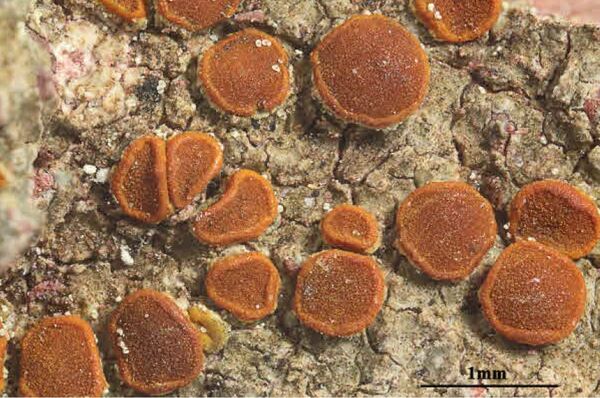Kuettlingeria neotaurica (Vondrák, Khodos., Arup & Søchting) I.V. Frolov, Vondrák & Arup
in Frolov & al., J. Syst. Evol. 59, 3: 468, 2020. Basionym: Caloplaca neotaurica Vondrák, Khodos., Arup & Søchting - in Vondrák & al., Lichenologist, 44: 414, 2012.
Synonyms: Caloplaca neotaurica Vondrák, Khodos., Arup & Søchting; Pyrenodesmia neotaurica (Vondrák, Khodos., Arup & Søchting) S. Y. Kondr.
Distribution: N - Lig (Herb. Vondrák 10755). C - Sar (Vondrák & al. 2012). S - Cal (Herb. Vondrák 10872), Si (Herb. Vondrák 10802).
Description: Thallus crustose, episubstratic, usually <150 µm thick, dark grey to brown-black, rarely white-pruinose, continuous to rimose or indistinctly areolate, delimited by a dark grey prothallus. Apothecia biatorine, up to 0.7 mm across, with an orange-red disc (grey in variants without anthraquinones), and a usually paler proper margin. Proper exciple c. 100-130 µm thick, prosoplectenchymatous; epithecium orange-brown, K+ red, C+ purple; hymenium colourless, 90-110 µm high; paraphyses branched and anastomosing, the apical cells to 5(-6) µm wide; hypothecium colourless. Asci 8-spored, cylindrical-clavate, functionally unitunicate, apically thickened with a broad internal beak, the inner part of apex and external cap I+ blue, Teloschistes-type. Ascospores 2-celled, polarilocular, hyaline, 14-17 x 7.5-10.5 µm, the equatorial thickening (“septum”) 4-7.5 µm. Pycnidia common, dark, the wall darker and K+ violet around the ostiole. Conidia narrowly ellipsoid, 2.5-3.5 x 1-1.5 µm. Photobiont chlorococcoid. Spot tests: thallus and pycnidial walls K+ fleeting violet, C-, KC-, P-, N+ purple; apothecia K+ and C+ red (reactions best seen in thick sections under the microscope). Chemistry: thallus and pycnidial walls with the Sedifolia-grey pigment; apothecia with chlorinated anthraquinones, 7-Cl-emodin major, citreorosein and emodinal in traces(chemosyndrome C2 sensu Søchting 2001). Note: a recently-described, mainly coastal species of siliceous rocks, related to K. fuscoatroides. The sample from Liguria was collected on coastal siliceous cliffs near Levanto. The identity of the samples collected by Vondrák in upland areas of Calabria and Sicily awaits confirmation based on molecular data.
Growth form: Crustose
Substrata: rocks
Photobiont: green algae other than Trentepohlia
Reproductive strategy: mainly sexual
Poorly known taxon in need of further study
Commonnes-rarity: (info)
Alpine belt: absent
Subalpine belt: absent
Oromediterranean belt: absent
Montane belt: very rare
Submediterranean belt: extremely rare
Padanian area: absent
Humid submediterranean belt: absent
Humid mediterranean belt: very rare
Dry mediterranean belt: extremely rare

Predictive model
Growth form: Crustose
Substrata: rocks
Photobiont: green algae other than Trentepohlia
Reproductive strategy: mainly sexual
Poorly known taxon in need of further study
Commonnes-rarity: (info)
Alpine belt: absent
Subalpine belt: absent
Oromediterranean belt: absent
Montane belt: very rare
Submediterranean belt: extremely rare
Padanian area: absent
Humid submediterranean belt: absent
Humid mediterranean belt: very rare
Dry mediterranean belt: extremely rare

Predictive model
 Index Fungorum
Index Fungorum
 GBIF
GBIF



